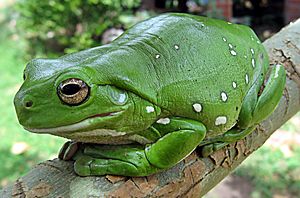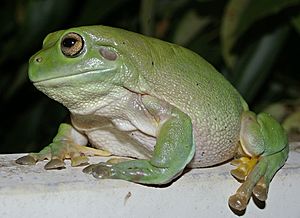Australian green tree frog facts for kids
Quick facts for kids Australian green tree frog |
|
|---|---|
 |
|
| Conservation status | |
| Scientific classification | |
| Kingdom: | |
| Phylum: | |
| Class: | |
| Order: | |
| Family: | |
| Genus: | |
| Binomial name | |
| Litoria caerulea (White, 1790)
|
|
The Australian green tree frog is a type of tree frog. People in Australia often call it the green tree frog. Other names are White's tree frog or dumpy tree frog. Its scientific name is Litoria caerulea.
These frogs live in Australia and New Guinea. They have also traveled to the United States and New Zealand on ships. The green tree frog is the biggest frog in Australia. It can grow up to 10 centimeters (4 inches) long.
Green tree frogs are easy to care for. They can live for about sixteen years if they are kept as pets. They often live near human homes, sometimes on windows or even inside houses! When a green tree frog feels unsafe, it screams to scare away dangers. If you touch it, it might squeak.
Many people know this frog because of how it looks and acts. It is also a popular pet around the world. The frog's skin has special stuff that fights bacteria and viruses. Scientists are studying this to see if it can help make medication for people in the future.
Contents
About the Green Tree Frog
The green tree frog is part of a group of tree frogs called Litoria. These frogs are found in Australasia. The frog is also known as "White's tree frog". It was named after John White, who first found the species in 1790. This was the first frog from Australia to be officially named by scientists.
When John White first sent these frogs to England, the special liquid used to keep them safe made them look blue. This is why its scientific name, caerulea, means "blue" in Latin. The frog's skin actually has blue and green colors under a yellow layer. The liquid destroyed the yellow layer, making the frogs look blue.
What They Look Like
The green tree frog can grow up to 10 centimeters (4 inches) long. Its color can change. It might be brown or green, depending on the temperature and its surroundings. The inside of its mouth is white. Sometimes, it has small white spots on its back.
At the end of its toes, the frog has large, sticky pads called discs. These discs help the frog climb easily. Its eyes are golden. The frog's fingers have webs between them, which help it swim. You can also see a round ear drum, called the tympanum membrane, on the side of its head.
The green tree frog looks a bit like the magnificent tree frog (Litoria splendida). This frog lives in north-western Australia. The magnificent tree frog has bigger bumps, called glands, on its head. The giant tree frog (Litoria infrafrenata) can also be confused with the green tree frog. But the giant tree frog has white stripes along its lower jaw, which the green tree frog does not have.
Green tree frog tadpoles change as they grow. They start out brown and become green later. Their underside is dark at first, then turns white when they become adult frogs. The eggs are brown and are found in clear jelly.
These frogs breathe through their lungs and also through their skin. For their skin to work, it needs to stay moist. Their skin also makes special chemicals called peptides. These peptides help fight off germs that could make the frog sick. Some of these peptides, called caerins, have antibacterial and antiviral properties. Scientists have even found peptides from the frog's skin that can fight HIV without harming healthy cells.

Where They Live
The green tree frog lives in the northern and eastern parts of Australia. It also lives in southern New Guinea, especially in drier areas. You can find it from Irian Jaya to Port Moresby and on Daru Island. Some frogs found in northern New Guinea might have been brought there by people. The International Conservation Union (IUCN) says these frogs are found in many different places.
Green tree frogs have also been brought to the United States and New Zealand. In the US state of Florida, you can find small groups of them. People think they arrived there because of the pet trade. It's not known if they cause any problems for the local environment. In New Zealand, there used to be many green tree frogs, but no one has seen them since the 1950s.
How They Live
Green tree frogs are active at night. During the day, they like to rest in cool, dark, and moist places. In winter, they are less active and don't make many sounds.
These frogs can live in many different places. They are found in tree branches and near slow-moving water. They can also live in swamps or grasslands in cooler areas. Green tree frogs are known for living inside houses. They might be found in sinks, toilets, or on windows. They like places like water tanks and gutters because these spots are humid and cooler. During mating season, they gather near these places because the structures help make their calls louder.
The green tree frog's call is a low, slow Brawk-Brawk-Brawk. They repeat this sound many times. Most of the year, they call from high places like trees or gutters. During mating season, they call near water. Like many frogs, they call to find a mate and to let other frogs know they are around. If they feel in danger, they will make a loud stress call.
Green tree frogs eat insects and spiders. They can also eat smaller frogs and even tiny mammals. Their teeth are not for chewing, so they have to swallow their food whole. They have very sticky tongues, which they use to catch small prey. For bigger prey, they jump on it and use their hands to push it into their mouths.
A few animals hunt green tree frogs. These include snakes, some types of lizards, and birds. Dogs and cats have also been known to catch and eat them. Green tree frogs can live up to sixteen years if they are kept as pets. Some have even lived for over twenty years! In the wild, they usually don't live as long because of predators.
As a Pet
The green tree frog is one of the most popular pet frogs in the world. People like them because they are calm and live a long time. They also look a bit like a cartoon frog! They are easy to care for because their food is not expensive, and they don't get sick easily.
A common problem for pet owners is feeding them too much. Green tree frogs can become overweight if they eat too much. In the wild, they use a lot of energy to hunt for food. But as pets, they are given live food and live in comfortable homes. This can make them lazy and gain weight. An overweight frog will have fat layers on its head and body, making it look "dumpy." This is why some pet owners call them "dumpy tree frogs."
Protecting Them

In Australia, the green tree frog is protected by a law called the Environment Protection and Biodiversity Conservation Act 1999. The IUCN lists the frog as "least concern". This means they are not in danger of disappearing. They are found in many places, and their numbers are not going down.
Some of the places where green tree frogs live have been destroyed. Also, some frogs have been found with a sickness called chytridiomycosis, caused by a fungus. Even though some groups of green tree frogs in Australia are getting smaller, the species as a whole is not yet endangered. This is partly because they live for a long time.
Images for kids
See also
 In Spanish: Rana arborícola de White para niños
In Spanish: Rana arborícola de White para niños







